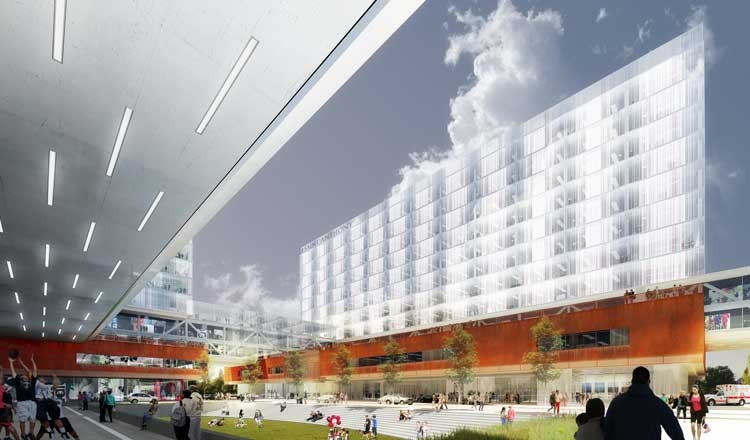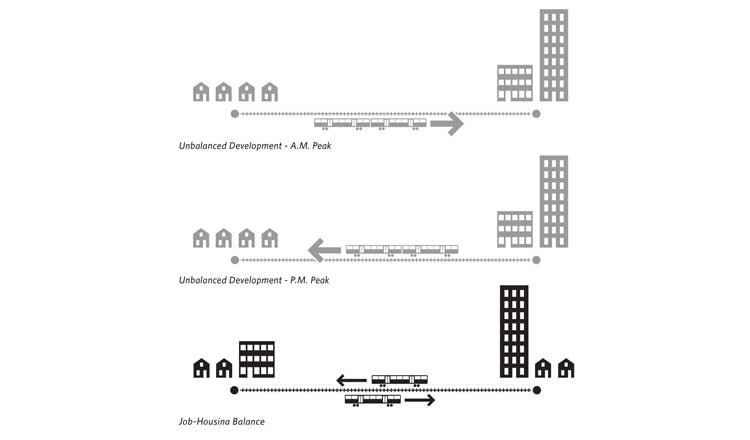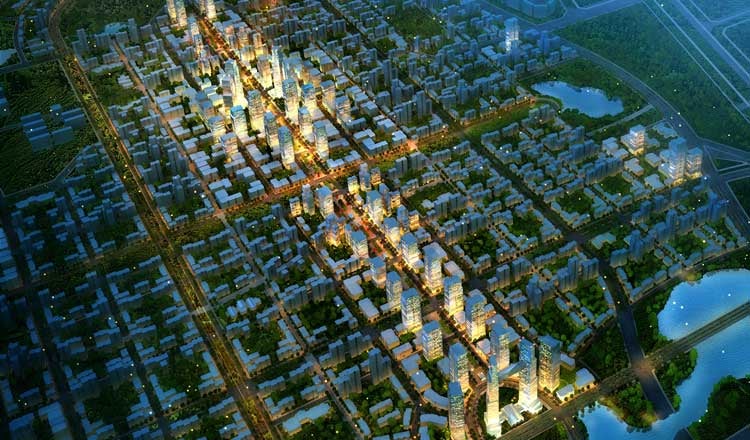
Ending Global Sprawl: Mix Uses and Users
This article was originally published in Ending Global Sprawl: Urban Standards for Sustainable and Resilient Development, written by Peter Calthorpe and published by the World Bank's Global Platform for Sustainable Cities. Ending Global Sprawl explores forward-thinking planning strategies for the urban form.
Principle 5: Mix Uses and Users
Create diverse, mixed-use neighborhoods and districts that integrate affordable housing.
Rationale and Challenges
Mixed-use — the intermingling of residential, commercial, civic services, and workplace opportunities — guarantees access to amenities and services that are close to where people live. Mixed users means providing housing and services for a complete range of incomes and household types. A certain level of both types of mix allows residents to access important amenities without traveling far distances, thus saving time, decreasing car use, improving quality of life, and integrating a complete, inclusive community. This is especially important for developments with elderly or children, as it is more difficult for them to travel independently, especially in areas with wide roads dominated by cars. Mixed-use districts and neighborhoods should be established in a city master plan to seamlessly combine TODs, major commercial areas, and residential districts.
Mixed-use is one of the most difficult principles to quantify for every neighborhood, region, or country. Yet, for neighborhoods to be accessible and vibrant, it is one of the most important. Lack of appropriate zoning, inattention to human-scale, loss of pedestrian connections, and urban sprawl are some of the most significant challenges to implementing mixed-use development.
In the private sector, developers often lack incentives or zoning to engage in mixed-use development, which is harder to finance, permit and market. In addition, lack of commercial property management in residential areas often results in mixed-use areas that are too noisy, dirty, or plagued with vacancies. While mixed-use neighborhoods require more attention in terms of management and planning for larger developers, they can increase property values, strengthen community, and improve economic growth for the area.
Diversity is key to a successful mixed-use development. Achieving complete life-cycle neighborhoods include mixing social housing, affordable rental, first-time low-cost home ownership, larger family housing, empty nester condos, and senior housing. The challenge is that each is produced and marketed by specialists with differing financing, zoning and construction types. Appropriate planning, financing, inclusionary requirements, and organic building opportunities can support integrating differing incomes and age groups.

Goals and Actions
5A: Encourage an optimal balance of housing, shops and services
- ACTION 1: Create a great walking experience with ground floor shops and services
- ACTION 2: Provide opportunities for residential development in commercial blocks
- ACTION 3: Within each residential neighborhood, cluster schools, social services and civic uses
5B: Create a jobs/housing balance within a short transit commute distance
- ACTION 4: Develop a citywide pattern of mixed-use districts that balance jobs and housing
5C: Integrate affordable and senior housing in each neighborhood
- ACTION 5: Establish districtwide affordable housing strategies and financing mechanisms

Metrics
5.1: Services Minimum
High-density residential blocks of more than 50 dwelling units/acre must provide at least 0.15 floor area ratio to publicly accessible shops and services at block corners
5.2: Commercial Destinations
Cluster shopping districts with civic uses and services within 800 meters of 80% of housing
5.3: Affordable Housing
At least 20% of housing in a neighborhood should be affordable

Benefits
Economic
- Increases property values: Property values increase from mixed-use neighborhoods.
- Saves households money: Households save money and time due to the availability of local goods and services. This allows people to meet their everyday needs with fewer long-distance trips.
Environmental
- Improves air quality: Mixed-use promotes non-motorized transit which decreases energy use and related air emissions.
- Reduces car use: Mixed-use neighborhoods are less likely to have car commuters because of a better jobs/resident balance and transit opportunities.
- Optimizes energy use: Creates a more varied energy load demand profile, reducing peak load pressure for more cost-effective and reliable electricity demand conditions.
Social
- Improves health: Provides opportunities for increased walking and active transportation.
- Increases access to amenities: for the elderly, children and handicapped residents.
About the Author: Peter Calthorpe

Peter’s long and honored career in urban design, planning and architecture began in 1976, combining his experience in each discipline to develop new approaches to urban revitalization, suburban growth and regional planning. In 1983, Peter founded the award-winning firm of Calthorpe Associates devoted to sustainable urban design and planning globally. In May 2019, Calthorpe Associates joined HDR. Throughout his career in urban design, planning and architecture, he has been a pioneer of innovative approaches to urban revitalization, community planning, and regional design. For his contribution in redefining the models of urban and suburban growth, he was awarded Urban Land Institute's prestigious J.C. Nichols Prize for Visionaries in Urban Development in 2006. He is one of the founders and the first board president of Congress for the New Urbanism. Metropolis Magazine claims: "The titles of Peter Calthorpe’s books define the recent history of urban design in its most vital and prescient manifestations."

